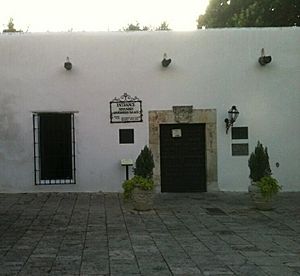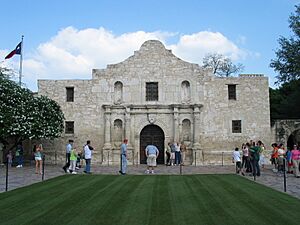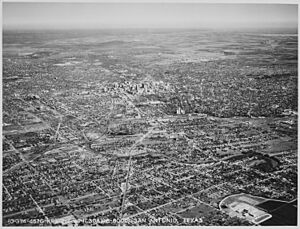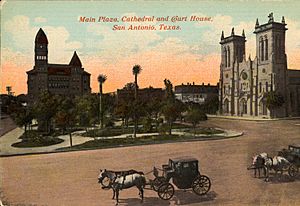History of San Antonio facts for kids
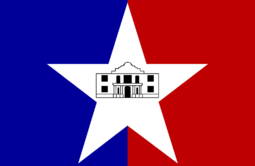 |
|
| Proportion | 5:9 |
|---|---|
| Adopted | August 27, 1992 |
| Design | A vertical bi-color of blue on the left and red on the right, with a large white star in the center, containing a black-outlined Alamo in the middle |
| Designed by | William W. Herring |
The city of San Antonio is one of the oldest Spanish settlements in Texas. For many years, it was the largest city in the state. Before the Spanish arrived, different groups of indigenous peoples lived here for thousands of years. The Payaya Indians were likely the first Native Americans to meet the Europeans.
Spanish explorers founded "Villa de Bejar" on May 5, 1718. This happened at the start of the San Pedro Creek. They built the Mission San Antonio de Valero and a fort called a presidio nearby. The Spanish colonial city then grew around these sites. San Antonio became an important trading post and the capital of Tejas, a province of colonial Spain. It was the northernmost Spanish settlement connected to the culture of Mexico.
After Mexico became independent in 1821, settlers from the United States, called Anglo-Americans, moved into the area. In 1836, these Anglo-Americans gained control of Texas. This led to the creation of the Republic of Texas. In 1845, Texas joined the United States and became a state.
Contents
Early History of San Antonio
For thousands of years, different Native American groups lived in the area. The Payaya Indians became a distinct group. They lived near the San Antonio River Valley and the San Pedro Springs. They called this area Yanaguana, which means “refreshing waters.”
In 1536, Álvar Núñez Cabeza de Vaca, a Spanish explorer, visited what would become Texas. He had been shipwrecked and lived among Native Americans for a time. He saw and described the river that would later be named the San Antonio River.
Spanish leaders in Mexico wanted to explore and settle the Texas region. It was very important to the Spanish crown. In 1675, an expedition was sent to explore the land beyond the Rio Grande. They wanted to see if new settlements were possible.
In 1691, a group of Spanish explorers and missionaries found the river and a Native American village. This was on June 13, the feast day of Saint Anthony of Padua. So, they named the place and the river San Antonio in his honor.
In 1709, another expedition explored the area where San Antonio is now. Fray Antonio de Olivares then traveled to Spain. He wanted to convince the Spanish leaders to build new missions along the San Antonio River.
In 1716, Fray Antonio de Olivares wrote to the Viceroy of New Spain. He shared his hopes for a future mission. He asked for families to come and settle a town. He also said that some families should be skilled in useful trades. This was "to teach the Indians all that should be required to be useful and capable citizens."
Finally, the Viceroyalty approved the mission in late 1716. They gave the job of setting it up to Martín de Alarcón, the governor of Coahuila y Tejas.
Spanish Settlement in Texas
Fray Antonio de Olivares went to a mission site suggested earlier. He stayed there alone after starting the new mission. He often met with the local Payaya Indians. He slowly earned their trust and respect. This mission was named San Antonio de Valero. Its name came from "San Antonio de Padua" and Viceroy New Spain, Marquess of Valero. It was built near a group of Coahuiltecan people.
Fray Antonio de Olivares also built the Presidio San Antonio de Béxar. This fort was on the west side of the San Antonio River, about a mile from the mission. Its purpose was to protect the missions and settlements in central Texas. It also helped Spain claim the region against other European countries. The presidio was a simple adobe building with grass roofs. Soldiers lived in brush huts.
As settlers gathered around the fort and mission, the town of Bejar (or Bexar) began to form. It became a key Spanish settlement in Texas. Because it was near several missions, Bejar did not suffer as much as other forts. The fort's walls were never fully finished because the mission later became the main walled defense.
The Spanish also built the first irrigation ditch in Texas. This was the Acequia Madre de Valero. It was 6 miles long and helped water 400 acres of land. It also supplied water to the new settlements. It was very important for the missions to control water from the San Antonio River. This allowed them to grow crops and provide water for the people. This ditch was the start of a much larger system of irrigation canals.
The Acequia Madre de Valero ran from what is now Brackenridge Park south to Hemisfair Plaza. Part of it runs under the Menger Hotel. The ditch was restored in 1968 and became a Recorded Texas Historic Landmark.
Fray Antonio de Olivares received help from local Payaya Indians and Pastia Indians. They helped him build the bridge that connected the Misión de San Antonio de Valero and Presidio San Antonio de Bexar. They also helped build the Acequia Madre de Valero.
On May 1, 1718, Martin de Alarcon officially gave the Misión de San Antonio de Valero to Fray Antonio de Olivares. This mission later became known as "The Alamo."
On May 5, the Presidio San Antonio de Bexar was founded. This fort on the west side of the San Antonio River became the start of the modern city. About 30 families settled around it.
On July 8, 1718, the first baptism happened at the new Mission San Antonio de Valero. This was recorded in the mission's baptism book.
In 1719, the Marquess of San Miguel de Aguayo suggested bringing 400 families from the Canary Islands, Galicia, or Habana to Texas. In June 1730, 25 families came to Cuba, and 10 families were sent to Veracruz. Led by Juan Leal Goraz, the group traveled to the Presidio San Antonio de Bexar. They arrived on March 9, 1731. These families joined the military community already there. They formed the first government of the city.
In 1719, another mission, Mission San José y San Miguel de Aguayo, was founded near the San Antonio River. This happened on February 23, 1720.
San Antonio grew to be the largest Spanish settlement in Texas. It was the farthest northeastern point of Hispanic culture from Mexico. For most of its history, the city was the capital of the Spanish, and later Mexican, province of Tejas. From San Antonio, the Camino Real (now Nacogdoches Road) led to the American border.
The Texas Revolution
After Mexico became independent from Spain in 1821, Anglo American settlers began moving to Texas. The Mexican government invited them through agents called Empresarios, like Stephen F. Austin. These settlers moved into areas east and northeast of San Antonio.
In 1833, Antonio López de Santa Anna became President of Mexico. He then changed the Mexican Constitution of 1824. This caused fighting in many parts of Mexico. In Texas, Anglo settlers joined many Hispanic Texans, called Tejanos. They all demanded a return to the 1824 Constitution. In several battles, the Anglo Texans (called Texians) and their Tejano allies forced the Mexican army to leave Texas.
In December 1835, Texian forces captured San Antonio. This was during the Battle of Bexar, led by Ben Milam. They defeated forces led by General Martin Perfecto de Cos, Santa Anna's brother-in-law. Forces against Santa Anna then controlled all of Texas. Today, Milam Park and the Cos House in San Antonio remember this battle.
Battle of the Alamo
After putting down other rebellions in Mexico, Santa Anna led a Mexican army back into Texas in spring 1836. He marched on San Antonio to get revenge for Cos's defeat and end the Texas rebellion. Sam Houston believed San Antonio could not be defended against the Mexican army. He told the Texan forces to leave the city.
However, a group of volunteers decided to stay. They were led by William Barrett Travis and James Bowie. This group included Davy Crockett and his men, and Juan Seguin's company of Hispanic Texan volunteers. They occupied and fortified the nearby deserted mission, the Alamo. They were determined to hold the Alamo against all odds.
The Alamo defenders included both Anglo and Hispanic Texans. They fought together under a flag that showed "1824" on the Mexican flag. This meant they were fighting for their rights under the Mexican constitution of that year. While they were under siege, the Texas Congress declared Texas an independent republic.
The Battle of the Alamo took place from February 23 to March 6, 1836. At first, it was mainly a siege with cannon fights and small clashes. After twelve days, Santa Anna decided to attack the Alamo directly.
Before dawn on March 6, he sent his troops against the Alamo walls. The third attack broke through the weak north wall. The defenders retreated to the Long Barracks and the Chapel. They fought until every man was gone. Most historians agree that a few defenders were captured but were quickly executed as rebels by Santa Anna's orders. The deaths of these "Martyrs to Texas Independence" inspired more resistance. The cry, "Remember the Alamo," became a rallying point for the Texas Revolution.
Aftermath of the Revolution
Texas won its independence at the Battle of San Jacinto on April 21.
Juan Seguín had organized the company of Tejanos who fought at the Alamo. He was with Sam Houston when the Alamo fell. He had left the besieged fort as a messenger for Travis. Houston told him not to return. Seguín later became famous for leading Tejano volunteers at the Battle of San Jacinto. After Texas won independence, he was elected to the Texas Senate. He later became mayor of San Antonio. In 1842, Anglo-American politicians forced him out of office. The next Hispanic person elected mayor of the city was Henry Cisneros in 1981.
As San Antonio has grown, the Alamo has become a key part of the modern city center. In 1836, it was separated from downtown by the San Antonio River. Alamo Plaza has the Cenotaph, a monument built to celebrate 100 years since the battle. It lists the names of all known Texans who fought there. The Alamo is San Antonio's most famous landmark. It is on the city's flag and seal. It is also the most visited tourist attraction in Texas. San Antonio is often called the "Alamo City." Its yearly Fiesta Week in April celebrates the Texian victory at San Jacinto.
Texas Joins the United States
In 1845, the United States added Texas as a state. This led to the Mexican War between the United States and Mexico. The war ended with the Treaty of Guadalupe Hidalgo in 1848. Under this treaty, Mexico gave the United States Texas and much of what is now the American Southwest. The war was very hard on San Antonio. By the end of the war, the city's population had dropped by almost two-thirds, to 800 people. A Cholera outbreak in 1849 killed hundreds more residents.
Peace and trade with the United States brought prosperity back to the city. By 1860, at the start of the Civil War, San Antonio had grown to 15,000 people. From the late 1840s, many people from Germany moved to Texas. They often opposed slavery because they had fought for justice and freedom in their home country. The most successful German merchants built homes in the King William district, just south of downtown. Visitors often heard German spoken on the streets as much as English and Spanish. Germans also started the beer and brewing industry in Texas. Places like Guenther Flour Mills and Mahncke Park remind people of San Antonio's German heritage.
Civil War and After
During the American Civil War, San Antonio was not strongly involved in the fight to leave the Union. Many residents, especially those of German, African, and Mexican backgrounds, supported the Union. After the war, they supported the Republican Party for many years.
After the war, San Antonio became a successful center for cattle ranching. Anglo Americans learned how to herd cattle on horseback from Spanish and Mexican traditions. This created a new generation of cowboys. Major cattle trails, like the Chisholm Trail, started in San Antonio. These trails moved cattle to markets and railroads. John Warne Gates, a business promoter, showed how useful his barbed wire was for herding cattle. In 1876, he fenced off Alamo Plaza with barbed wire. When the wire held the cattle, many ranchers ordered the new product. San Antonio was important at both the beginning and end of the open-range ranching period in America.
After the Civil War, San Antonio remained a frontier city. Its distant location and mix of cultures made it seem like an exotic place. When Frederick Law Olmsted, who designed Central Park in New York City, visited San Antonio in 1856, he described it as having a "jumble of races, costumes, languages, and buildings." He said it had a unique "odd and antiquated foreignness," like New Orleans. Much of what makes San Antonio a tourist spot today comes from its unique history.
In 1850, San Antonio became the largest city in Texas with 8,235 people. It took the lead from Galveston. With its first railroad built in 1877, and after a terrible hurricane hit Galveston in 1900, San Antonio became the state's largest city again. It stayed the largest until 1930, when Dallas and Houston grew bigger. The railroad connected San Antonio to major markets and the rest of American society.
San Antonio was often visited by gun fighters and outlaws of the Old West. It is especially linked with Butch Cassidy and the Sundance Kid, who were part of the Wild Bunch.
Modern Times
At the start of the 20th century, the streets of Downtown San Antonio were made wider. This was to make room for streetcars and modern traffic. Many historic buildings were torn down during this process. This included the Veramendi House, a large adobe building.
Like many cities in the Southern United States, San Antonio has grown steadily since the late 20th century. The city's population has almost doubled in 35 years. It grew from over 650,000 people in 1970 to an estimated 1.2 million in 2005. This growth came from more births, people moving there, and the city adding more land.
See also
- Acequia Madre de Valero
- San Antonio Sporting District
- Isleño
- Timeline of San Antonio



